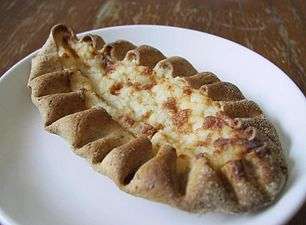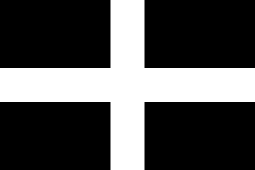Pasty
A pasty (/ˈpæsti/[1]) is a baked pastry, a traditional variety of which is particularly associated with Cornwall, United Kingdom. It is made by placing an uncooked filling, typically meat and vegetables, on one half of a flat shortcrust pastry circle, folding the pastry in half to wrap the filling in a semicircle and crimping the curved edge to form a seal before baking.
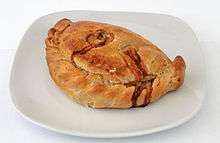 A Cornish pasty | |
| Course | Main, snack |
|---|---|
| Place of origin | United Kingdom |
| Region or state | Often associated with Cornwall |
| Serving temperature | Hot or cold |
| Main ingredients | A pastry case traditionally filled with beef skirt, potato, swede (turnip) and onion. |
| Variations | Cheese and onion, cheese and potato |
| Varies kcal | |
The traditional Cornish pasty, which since 2011 has Protected Geographical Indication (PGI) status in Europe,[2] is filled with beef, sliced or diced potato, swede (also known as yellow turnip or rutabaga – referred to in Cornwall as turnip) and onion, seasoned with salt and pepper, and baked. Today, the pasty is the food most associated with Cornwall. It is regarded as the national dish and accounts for 6% of the Cornish food economy. Pasties with many different fillings are made and some shops specialise in selling all sorts of pasties.
The origins of the pasty are unclear, though there are many references to them throughout historical documents and fiction. The pasty is now popular worldwide due to the spread of Cornish miners and sailors from across Cornwall, and variations can be found in Australia, Mexico, the United States, Ulster and elsewhere.
Pasties also resemble turnovers from many other cuisines and cultures, including the bridie in Scotland, empanada in Spanish-speaking countries, pirog in Eastern Europe, tourtière in Canada and shaobing in China.
History
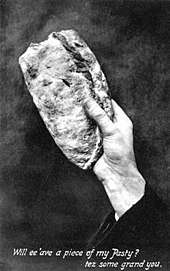
Despite the modern pasty's strong association with Cornwall, its exact origins are unclear. The English word "pasty" derives from Medieval French (O.Fr. paste from V.Lat pasta[3]) for a pie, filled with venison, salmon or other meat, vegetables or cheese, baked without a dish.[4] Pasties have been mentioned in cookbooks throughout the ages. For example, the earliest version of Le Viandier (Old French) has been dated to around 1300 and contains several pasty recipes.[5] In 1393, Le Menagier de Paris contains recipes for pasté with venison, veal, beef, or mutton.[6]
Other early references to pasties include a 13th-century charter that was granted by Henry III (1207–1272) to the town of Great Yarmouth. The town is bound to send to the sheriffs of Norwich every year one hundred herrings, baked in twenty four pasties, which the sheriffs are to deliver to the lord of the manor of East Carlton who is then to convey them to the King.[7] Around the same time, 13th-century chronicler Matthew Paris wrote of the monks of St Albans Abbey "according to their custom, lived upon pasties of flesh-meat".[8] A total of 5,500 venison pasties were served at the installation feast of George Neville, archbishop of York and chancellor of England in 1465.[9] The earliest reference for the Devon pasty can be found in Plymouth City Records of 1509/10, which describe "Itm for the cooke is labor to make the pasties 10d."[10] They were even eaten by royalty, as a letter from a baker to Henry VIII's third wife, Jane Seymour (1508–1537) confirms: "...hope this pasty reaches you in better condition than the last one ..."[11] In his diaries written in the mid-17th century, Samuel Pepys makes several references to his consumption of pasties, for instance "dined at Sir W. Pen's ... on a damned venison pasty, that stunk like a devil.",[12] but after this period the use of the word outside Devon and Cornwall declined.[13]
In contrast to its earlier place amongst the wealthy, during the 17th and 18th centuries, the pasty became popular with working people in Cornwall, where tin miners and others adopted it due to its unique shape, forming a complete meal that could be carried easily and eaten without cutlery.[14][15][16] In a mine, the pasty's dense, folded pastry could stay warm for several hours, and if it did get cold, it could easily be warmed on a shovel over a candle.[17]
Side-crimped pasties gave rise to the suggestion that the miner might have eaten the pasty holding the thick edge of pastry, which was later discarded, thereby ensuring that his dirty fingers (possibly including traces of arsenic) did not touch food or his mouth.[18] However, many old photographs show that pasties were wrapped in bags made of paper or muslin and were eaten from end to end;[19] according to the earliest Cornish recipe book, published in 1929, this is "the true Cornish way" to eat a pasty.[20] Another theory suggests that pasties were marked at one end with an initial and then eaten from the other end so that if not finished in one go, they could easily be reclaimed by their owners.[17]
Cornish pasty

The pasty is regarded as the national dish of Cornwall,[21][22][23] and an early reference is from a New Zealand newspaper:
In Cornwall, there is a common practice among those cottagers who bake at home of making little pasties for the dinners of those who may be working at a distance in the fields. They will last the whole week, and are made of any kind of meat or fruit, rolled up in a paste made of flour and suet or lard. A couple of ounces of bacon and half a-pound of raw potatoes, both thinly sliced and slightly seasoned, will be found sufficient for the meal. The pasty can be carried in the man's pocket.
The term "Cornish pasty" has been in use since at least the early 1860s:
The Cornish pasty, which so admirably comprises a dinner in itself—meat, potatoes, and other good things well cooked and made up into so portable a form—was a subject of much admiration, and reminded me of the old coaching days, when I secured a pasty at Bodmin in order to take it home to my cook, that it might be dissected and serve as a pattern for Cornish pasties in quite another part of the country.
Cornish pasties are very popular with the working classes in this neighbourhood, and have lately been successfully introduced into some parts of Devonshire. They are made of small pieces of beef, and thin slices of potatoe, highly peppered, and enclosed in wrappers of paste.
By the late 19th century, national cookery schools began to teach their pupils to create their own version of a "Cornish pasty" that was smaller, and was to be eaten as an "economical savoury nibble for polite middle-class Victorians".[27][28][29]
On 20 July 2011, after a nine-year campaign by the Cornish Pasty Association – the trade organisation of about 50 pasty makers based in Cornwall – the name "Cornish pasty" was awarded Protected Geographical Indication (PGI) status by the European Commission.[30] According to the PGI status, a Cornish pasty should be shaped like a 'D' and crimped on one side, not on the top. Its ingredients should include beef, swede (called turnip in Cornwall),[31] potato and onion, with a light seasoning of salt and pepper, keeping a chunky texture. The pastry should be golden and retain its shape when cooked and cooled.[18] The PGI status also means that Cornish pasties must be prepared in Cornwall. They do not have to be baked in Cornwall,[32] nor do the ingredients have to come from the county, though the Cornish Pasty Association (CPA) noted that there are strong links between pasty production and local suppliers of the ingredients.[33] Packaging for pasties that conform to the requirements includes an authentication stamp, the use of which is policed by the CPA.[18]
Producers outside Cornwall objected to the PGI award, with one saying "[EU bureaucrats could] go to hell".[34] Major UK supermarkets Asda and Morrisons both stated they would be affected by the change,[34] though Greggs was one of seven companies allowed to continue to use the name "Cornish pasty" during a three-year transitional period.[2]
Members of the CPA made about 87 million pasties in 2008, amounting to sales of £60 million (about 6% of the food economy of Cornwall).[35] In 2011, over 1,800 permanent staff were employed by members of the CPA and some 13,000 other jobs benefited from the trade.[36] Surveys by the South West tourism board have shown that one of the top three reasons people visit Cornwall is the food and that the Cornish pasty is the food most associated with Cornwall.[18]
Michael Ball, a Cornish-born businessman who is chief executive of WMC Retail Partners, Oxfordshire, is planning to establish a Cornish pasty museum at Cornish Market World near St Austell. He hopes to collect pasty-making artifacts and memorabilia for the museum.[37]
Definition and ingredients

| Wikibooks Cookbook has a recipe/module on |
The recipe for a Cornish pasty, as defined by its protected status, includes diced or minced beef, onion, potato and swede in rough chunks along with some "light peppery" seasoning.[18] The cut of beef used is generally skirt steak.[38] Swede is sometimes called turnip in Cornwall, but the recipe requires use of actual swede, not turnip.[31] Pasty ingredients are usually seasoned with salt and pepper, depending on individual taste.[39] The use of carrot in a traditional Cornish pasty is frowned upon, though it does appear regularly in recipes.[38]
The type of pastry used is not defined, as long as it is golden in colour and will not crack during the cooking or cooling,[18] although modern pasties almost always use a shortcrust pastry.[39] There is a humorous belief that the pastry on a good pasty should be strong enough to withstand a drop down a mine shaft,[40] and indeed the barley flour that was usually used does make hard dense pastry.[41]
Variations
Although the officially protected Cornish pasty has a specific ingredients list, old Cornish cookery books show that pasties were generally made from whatever food was available.[42] Indeed, the earliest recorded pasty recipes include venison, not beef.[43] "Pasty" has always been a generic name for the shape and can contain a variety of fillings, including stilton, vegetarian and even chicken tikka.[42] Pork and apple pasties are readily available in shops throughout Cornwall and Devon, with the ingredients including an apple flavoured sauce, mixed together throughout the pasty, as well as sweet pasties with ingredients such as apple and fig or chocolate and banana, which are common in some areas of Cornwall.[16]
A part-savoury, part-sweet pasty (similar to the Bedfordshire clanger) was eaten by miners in the 19th century, in the copper mines on Parys Mountain, Anglesey. The technician who did the research and discovered the recipe claimed that the recipe was probably taken to Anglesey by Cornish miners travelling to the area looking for work.[44] No two-course pasties are commercially produced in Cornwall today,[45] but are usually the product of amateur cooks.[39] They are, however, commercially available in the British supermarket chain Morrisons (under the name 'Tin Miner Pasty').[46] Other traditional fillings have included a wide variety of locally available meats including pork, bacon, egg, rabbit, chicken, mackerel and sweet fillings such as dates, apples, jam and sweetened rice - leading to the oft-quoted joke that 'the Devil hisself was afeared to cross over into Cornwall for fear that ee'd end up in a pasty'.[47]
A pasty is known as a "tiddy oggy" when steak is replaced with an extra potato, "tiddy" meaning potato and "oggy" meaning pasty and was eaten when times were hard and expensive meat could not be afforded.[48] Another traditional meatless recipe is 'herby pie' with parsley, freshly gathered wild green herbs and chives, ramsons or leeks and a spoonful of clotted cream.[47]
Shape
Whilst the PGI rules state that a Cornish pasty must be a "D" shape, with crimping along the curve (i.e., side-crimped),[34] crimping is variable within Cornwall, with some advocating a side crimp while others maintain that a top crimp is more authentic.[16][45]
Some sources state that the difference between a Devon and Cornish pasty is that a Devon pasty has a top-crimp and is oval in shape, whereas the Cornish pasty is semicircular and side-crimped along the curve.[39] However, pasties with a top crimp have been made in Cornwall for generations,[49] yet those Cornish bakers who favour this method now find that they cannot legally call their pasties "Cornish".[50]
In other regions
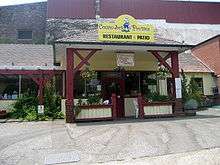
Migrating Cornish miners and their families (colloquially known as Cousin Jacks and Cousin Jennies) helped to spread pasties into the rest of the world during the 19th century. As tin mining in Cornwall began to decline, miners took their expertise and traditions to new mining regions around the world. As a result, pasties can be found in many regions, including:
- Many parts of Australia, including the Yorke Peninsula, which has been the site of an annual Cornish festival (claimed to be the world's largest) since 1973. A clarification of the Protected Geographical Status ruling has confirmed that pasties made in Australia are still allowed to be called "Cornish Pasties".[51]
- Pasties can be found in California and Nevada in many historical Gold Rush towns, such as Grass Valley and Nevada City.
- The Upper Peninsula of Michigan. In some areas, pasties are a significant tourist attraction,[52] including an annual Pasty Fest in Calumet, Michigan in mid August. Pasties in the Upper Peninsula of Michigan have a particularly unusual history. Many ethnic groups adopted the pasty for use in the Copper Country copper mines; the Finnish immigrants to the region mistook it for the traditional piiraat and kuuko pastries.[53][54] The pasty has become strongly associated with all cultures in this area, and in the similar Iron Range in northern Minnesota.[55]
- Mineral Point, Wisconsin, was the site of the first mineral rush in the USA during the 1830s. After lead was discovered in Mineral Point, many of the early miners migrated from Cornwall to this south-western Wisconsin area. Those Cornish miners brought their skills working in the deep underground tin mines of Cornwall. They also brought their recipe and appetite for the pasty.[56] Pasties can also be found in Madison, Wisconsin's capital city.[57]
- A similar local history about the arrival of the pasty in the area with an influx of Welsh and Cornish miners to the area's copper mines, and its preservation as a local delicacy, is found in Butte, Montana, "The Richest Hill on Earth".[58]
- The Anthracite regions of northeastern Pennsylvania, including the cities of Wilkes-Barre, Scranton, and Hazleton, had an influx of miners to the area in the 1800s and brought the pasty with them. To this day, pasties are still a local favourite. In 1981, a Pennsylvania entrepreneur started marketing pasties under the brand name Mr. Pastie.
- The Mexican state of Hidalgo, and the twin silver mining cities of Pachuca and Real del Monte (Mineral del Monte), have notable Cornish influences from the Cornish miners who settled there, with pasties being considered typical local cuisine. In Mexican Spanish, they are referred to as pastes.[59] The town of Real del Monte in Mexico is the site of a museum of pasties.[60] The annual International Pasty Festival is held in Real del Monte for three days each October.[61]
- They are also popular in South Africa, New Zealand[62] and Ulster.
- Pasties were modified with different spices and fillings in Jamaica, giving rise to the Jamaican patty.
- Similar dishes are found in many countries such as empanadas in Spanish speaking countries, Coulibiac in Eastern Europe, Tourtière in Canada and Shaobing in China.
Culture
Of goodly things the plenteous store:
The Sea and Fish that swim therein
And underground the Copper and Tin:
Let all the World say what it can
Still I hold by the Cornishman,
And that one most especially
The Merry Ballad of the Cornish Pasty
– Robert Morton Nance, 1898[40]
Literature
Pasties have been mentioned in multiple literary works since the 12th century Arthurian romance Erec and Enide, written by Chrétien de Troyes, in which they are eaten by characters from the area now known as Cornwall.[17][43] There is a mention in Havelok the Dane, another romance written at the end of the thirteenth century;[63] in the 14th century Robin Hood tales; in Chaucer's The Canterbury Tales;[17] and in three plays by William Shakespeare.[64][65][66]
Pasties appear in many novels, used to draw parallels or represent Cornwall. In American Gods by Neil Gaiman, main character Shadow discovers pasties at Mabel's restaurant in the fictional town of Lakeside. The food is mentioned as being popularised in America by Cornishmen, as a parallel to how gods are "brought over" to America in the rest of the story. Another literature reference takes place in The Cat Who ... series by Lilian Jackson Braun. Pasties are referred to as a cultural part of the north country, and Jim Qwilleran often eats at The Nasty Pasty, a popular restaurant in fictional Moose County, famous for its tradition of being a mining settlement. Reference to pasties is made in Brian Jacques' popular Redwall series of novels, where it is a staple favourite on the menu to the mice and hares of Redwall Abbey. Pasties also appear in the Poldark series of historical novels of Cornwall, by Winston Graham, as well as the BBC television series adapted from these works.
Superstitions, rhymes and chants
In the tin mines of Devon and Cornwall, pasties were associated with "knockers", spirits said to create a knocking sound that was either supposed to indicate the location of rich veins of ore,[67] or to warn of an impending tunnel collapse. To encourage the good will of the knockers, miners would leave a small part of the pasty within the mine for them to eat.[68] Sailors and fisherman would likewise discard a crust to appease the spirits of dead mariners, though fishermen believed that it was bad luck to take a pasty aboard ship.[68]
A Cornish proverb, recounted in 1861, emphasised the great variety of ingredients that were used in pasties by saying that the devil would not come into Cornwall for fear of ending up as a filling in one.[69] A West Country schoolboy playground-rhyme current in the 1940s concerning the pasty went:
Matthew, Mark, Luke and John, ate a pasty five feet long,
Bit it once, Bit it twice, Oh my Lord, it's full of mice.[40]
In 1959 the English singer-songwriter Cyril Tawney wrote a nostalgic song called "The Oggie Man". The song tells of the pasty-seller with his characteristic vendor's call who was always outside Plymouth's Devonport Naval Dockyard gates late at night when the sailors were returning, and his replacement by hot dog sellers after World War II.[70]
The word "oggy" in the internationally popular chant "Oggy Oggy Oggy, Oi Oi Oi" is thought to stem from Cornish dialect "hoggan", deriving from "hogen" the Cornish word for pasty. When the pasties were ready for eating, the bal maidens at the mines would supposedly shout down the shaft "Oggy Oggy Oggy" and the miners would reply "Oi Oi Oi".[71]
Giant pasties
As the national dish of Cornwall, several oversized versions of the pasty have been created in the county. For example, a giant pasty is paraded from Polruan to Fowey through the streets during regatta week.[72] Similarly, a giant pasty is paraded around the ground of the Cornish Pirates rugby team on St Piran's Day before it is passed over the goal posts.[73]
The world's largest Cornish pasty was made in August 2010, measuring 4.6 metres (15 ft) and weighing 860 kilograms (1,900 lb). It used 165 kg (364 lb) of beef, 180 lb (82 kg) of swede, 100 lb (45 kg) of potatoes and 75 lb (34 kg) of onions.
Gallery
- Pasties
- An uncooked pasty prior to crimping
 A two course pasty
A two course pasty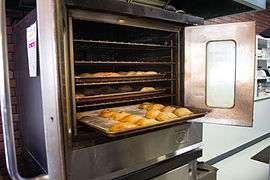 Pasties in the oven
Pasties in the oven- A Mexican "paste"
- Cornish Pirates players display a giant pasty
 Pasty varieties (Penzance)
Pasty varieties (Penzance)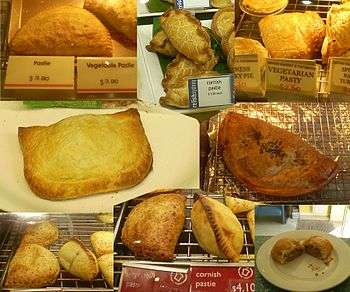 Pasty varieties (Australia)
Pasty varieties (Australia)
See also
- List of pastries
- List of pies, tarts and flans
- List of potato dishes
- Bedfordshire clanger - similar pastry dish from Bedfordshire which has one savoury filled end and one sweet filled end
- Bridie – Scottish equivalent
- Calzone – an Italian turnover or folded Pizza
- Chicken patty
- Cholera (food) - a Swiss savoury pastry similar to a cheese pasty
- Chiburekki – National dish of Crimean Tatars, also popular in the Balkans, Caucasus, and Central Asia
- Coventry Godcakes – originated in the city of Coventry, England
- Empanada or Empanadilla – similar dish from Iberia (Galicia) and Latin America
- Fleischkuekle – German-Russian meat pie
- Hot Pockets – well-known American microwavable convenience brand
- International Pasty Festival – Held annually in Mexico
- Jamaican patty – Jamaican equivalent
- Karelian pasty – similar open-faced dish in Karelia
- Kibinai - similar pasties (though smaller) in Lithuania
- Knish – an Eastern European and Jewish snack
- Natchitoches meat pie - Louisiana meat pie
- Panzerotti – smaller version of a calzone
- Paste – Mexican dish based on pasty
- Pirozhki – Russian equivalent
- Samosa – similar dish from South Asia
- World Pasty Championships – held annually in Cornwall
References
- Oxford Learner's Dictionaries, s.v. "pasty".
- "Commission Implementing Regulation (EU) No 717/2011 of 20 July 2011 entering a name in the register of protected designations of origin and protected geographical indications (Cornish Pasty (PGI))". Official Journal of the European Union. 54 (L 193): 13–14. 23 July 2011. ISSN 1725-2555. Retrieved 1 September 2011.
- "Online Etymology Dictionary". www.etymonline.com.
- Cambridge Dictionaries Online. "Pasty". Retrieved 14 June 2012.
- Scully, Terence, ed.; Taillevent (1988). The Viandier of Taillevent: an edition of all extant manuscripts. Pasty mentions: University of Ottawa Press. p. 361. ISBN 0-7766-0174-1.CS1 maint: multiple names: authors list (link) CS1 maint: extra text: authors list (link) CS1 maint: location (link)
- The Goodman of Paris. c. 1393. Archived from the original on 16 February 2009.
- Nuttall, P Austin (1840). A classical and archæological dictionary of the manners, customs, laws, institutions, arts, etc. of the celebrated nations of antiquity, and of the middle ages. London. p. 555.
- Brayley, Edward Wedlake (1808). The Beauties of England and Wales, Or Delineations, Topographical, Historical and Descriptive. VII (Hertford, Huntingdon and Kent). London: Thomas Maiden. p. 40.
- Encyclopædia Britannica 1823 vol VIII. Printed for Archibald Constable and Company. 1823. p. 585.
- "Devon invented the Cornish pasty". BBC. 13 November 2006. Retrieved 21 February 2019.
- Shackle, Eric (21 April 2001). "A short history of ... Cornish pasties | Life and style | The Observer". The Guardian. London. Retrieved 14 August 2009.
- "Thursday 1 August 1667". The Diary of Samuel Pepys. Phil Gyford. Retrieved 1 September 2011.
- Laura Mason & Catherine Brown (2007). From Bath Chaps to Bara Brith: The Taste of South West Britain. Harper Press. pp. 32–33. ISBN 978-0-7524-4742-1.
- Harris, J Henry (2009). Cornish Saints & Sinners. Wildside Press LLC. p. 195. ISBN 9781434453679.
- Devlin, Kate (25 July 2008). "The History of the Cornish Pasty". The Daily Telegraph. Retrieved 2 March 2011.
- Grigson, Jane (1993) English Food. Penguin Books, p. 226
- Miller, Luke; Westergren, Marc. "History of the Pasty". The Cultural Context of the Pasty". Michigan Technological University. Retrieved 13 March 2006.
- "Cornish Pasty (PGI)" (PDF). DEFRA. Archived from the original (PDF) on 2 April 2013. Retrieved 2 March 2011.
- Mansfield, Emma (2011). The Little Book of the Pasty. Cornwall: Lovely Little Books. p. 101. ISBN 978-1-906771-28-7.
- Martin, Edith (1929). Cornish Recipes: Ancient and Modern. Truro: A. W. Jordan.
- Robert A. Georges and Michael Owen Jones, Folkloristics: an introduction, Indiana University Press, 1995, pp. 127–128
- J. W. Lambert, Cornwall, Harmondsworth: Penguin Books, 1945, p. 38
- The West Briton, Commercial pasty companies are failing our Cornish national dish, 23 September 2010
- "Hints to Labourers". The Nelson Examiner and New Zealand Chronicle. II (66). 10 June 1843. p. 264. Retrieved 12 April 2020.
- Vivian, H. Hussey (1862). "Thursday August 28th. Evening Meeting". Archaeologia Cambrensis. London: J. Russell Smith. VIII. Third series: 329. Retrieved 7 September 2015.
- Halliwell, James Orchard (1861). "Rambles in Western Cornwall by the Footsteps of the Giants: With Notes on the Celtic Remains of the Land's End District and the Islands of Scilly". London: John Russell Smith: 40. Retrieved 11 September 2015.
potatoe.
Cite journal requires|journal=(help) - "Food historian says the Cornish did not invent the 'Cornish pasty'", The Cornishman, 29 August 2015 Archived 23 September 2015 at the Wayback Machine
- Browne, Phyllis (4 October 1890). "Chats with Housekeepers - Cornish Pasties". The Newcastle Weekly Courant. Newcastle-upon-Tyne.
- "Cornish pasties: Historian questions origin". BBC News. 2 September 2015.
- Poirier, Agnès (23 February 2011). "Putting the Cornish back into pasties". The Guardian. Retrieved 2 March 2011.
- Beckford, Martin (20 August 2010). "Turnip or swede? Brussels rules on ingredients of Cornish pasty". The Daily Telegraph. Retrieved 2 March 2011.
- "COUNCIL REGULATION (EC) No 510/2006 'CORNISH PASTY' EC No: UK-PGI-005-0727-11.11.2008". Official Journal of the European Union. 14 July 2010. Retrieved 9 August 2015. "Assembly of the pasties in preparation for baking must take place in the designated area. The actual baking does not have to be done within the geographical area, it is possible to send the finished but unbaked and/or frozen pasties to bakers or other outlets outside the area where they can be baked in ovens for consumption."
- "The Cornish Pasty Association's application for PGI". Cornishpastyassociation.co.uk. Archived from the original on 23 May 2009. Retrieved 14 August 2009.
- Wallop, Harry (22 February 2011). "Cornish pasty given EU protected status". The Daily Telegraph. Retrieved 2 March 2011.
- Savill, Richard (25 July 2008). "Cornish pasty in European battle for protected status". The Daily Telegraph. Retrieved 4 March 2011.
- "About the Cornish Pasty Association". Cornish Pasty Association. Archived from the original on 24 September 2011. Retrieved 3 September 2011.
- i (newspaper) 19 October 2015; "Cornwall's pride wrapped up in pastry"; Adam Lusher (pp. 26-27)
- Clarke, Felicity (23 February 2011). "Ultimate Cornish Pasty Recipe". The Guardian. Retrieved 4 March 2011.
- Ann Pringle Harris (7 February 1988). "Fare of the Country; In Cornwall, a Meal in a Crust". The New York Times. Retrieved 15 March 2005.
- Hall, Stephen (2001). The Cornish Pasty. Nettlecombe, UK: Agre Books. ISBN 0-9538000-4-0.
- Pascoe, Ann (1988). Cornish Recipes Old and New. Penryn: Tor Mark Press. p. 1. ISBN 0-85025-304-7.
- Trewin, Carol; Woolfitt, Adam (2005). Gourmet Cornwall. Alison Hodge Publishers. pp. 125–129. ISBN 0-906720-39-7.
- "Who invented the Cornish pasty?". The Independent. London. 13 November 2006. Retrieved 21 August 2017.
- "UK | Wales | North West Wales | Sweet-savoury pastie back on menu". BBC News. 26 March 2006. Retrieved 21 September 2009.
- Merrick, Hettie (1995). The Pasty Book. Penryn: Tor Mark Press.
- Ryan, Keith. "The Cornish Pasty presents: The Morrisons Tin Miner Pasty". www.cornishpasties.org.uk. Retrieved 15 January 2018.
- Cornish Recipes, Ancient & Modern, Edith Martin, Truro, 1929
- Bareham, Lindsey (21 November 2008). "The perfect pasty?". The Times. Retrieved 11 March 2011.
- "Cornish Pasty". Here and Now Magazine. Archived from the original on 12 January 2012. Retrieved 2 April 2011.
- Middleton, Kimberley (27 February 2011). "This is where the great pasty revolt begins". The Independent. Retrieved 2 April 2011.
- Pearlman, Jonathan (4 March 2011). "Australian Cornish pasty region concerned about protected ruling". The Daily Telegraph. Retrieved 11 March 2011.
- Silver, Kate (7 March 2014). "Prowling for pasties in the U.P." Chicago Tribune. Archived from the original on 27 May 2019. Retrieved 11 March 2014.
- Ojakangas, B. (1988). The Great Scandinavian Baking Book. Boston: Little, Brown, p. 308.
- "History of the Pasty". Houghton, Michigan: Michigan Technological University. Retrieved 21 December 2012.
- Shortridge, Barbara (1998). The taste of American place. Rowman & Littlefield. pp. 21–36. ISBN 0-8476-8507-1.
- Mineral Point Chamber of Commerce: A Brief History of Mineral Point, "Archived copy". Archived from the original on 25 November 2010. Retrieved 31 January 2011.CS1 maint: archived copy as title (link). Retrieved 31 January 2011
- https://isthmus.com/food-drink/reviews/the-new-teddywedgers-revives-the-cornish-pasty/
- Johanek, Durrae (2009). Montana Curiosities: Quirky Characters, Roadside Oddities & Other Offbeat Stuff. Globe Pequot. pp. 119–120. ISBN 978-0-7627-4302-5.
- "Pastes (Spanish)". Turismo del Gobierno del Estado de Hidalgo. Archived from the original on 11 June 2007. Retrieved 3 May 2008.
- i (newspaper) 19 October 2015; Cornwall's pride wrapped up in pastry; Adam Lusher (pp. 26-27)
- "Festival Internacional del Paste Real del Monte 2015", Donde Hay Feria (in Spanish), retrieved 11 August 2016
- "Who ate all the pies", The Press, Christchurch, New Zealand, 5 September 2009
- "Havelok the Dane". University of Rochester Robbins Library. Retrieved 1 September 2011. (line 645)
- In The Merry Wives of Windsor Act 1 Scene 1, Page says Wife, bid these gentlemen welcome. Come, we have a hot venison pasty to dinner: come gentlemen, I hope we shall drink down all unkindness.
- In All's Well That Ends Well, Act IV Scene III, Parrolles states: I will confess to what I know without constraint: if ye pinch me like a pasty, I can say no more.
- In Titus Andronicus, Titus bakes Chiron and Demetrius's bodies into a pasty, and forces their mother to eat them.
- Froud, Brian (2002). Faeries. Pavilion. ISBN 1-86205-558-0.
- National Trust (2007). Gentleman's Relish: And Other Culinary Oddities. Anova Books. pp. 78–9. ISBN 978-1-905400-55-3.
- Halliwell, James Orchard (1861). Rambles in Western Cornwall by the Footsteps of the Giants. London: John Russell Smith. pp. 40–41.
In fact so universal are the contents of Cornish pasties, a local proverb states that the devil will not venture into Cornwall, for if the inhabitants caught him, they would be sure to put him into a pie
- "Tawney in Depth – The background to some of Cyril's classic songs". cyriltawney.co.uk. Archived from the original on 26 August 2010. Retrieved 6 September 2011.
- Gibson, Rory (26 October 2010). "Time for Aussies to lose 'bogan' chant?". The Courier-Mail. Retrieved 11 March 2011.
- Jago, M (26 August 2008). "Regatta beats the odds". This is Cornwall. Archived from the original on 8 February 2012. Retrieved 4 March 2011.
- Richards, N (5 March 2010). "Pirates ready for big cup test". This is Cornwall. Archived from the original on 8 February 2012. Retrieved 4 March 2011.
Further reading
- The Cornish Pasty by Stephen Hall, Agre Books, Nettlecombe, UK, 2001 ISBN 0-9538000-4-0
- The Pasty Book by Hettie Merrick, Tor Mark, Redruth, UK, 1995 ISBN 978-0-85025-347-4
- Pasties by Lindsey Bareham, Mabecron Books, Plymouth, UK, 2008 ISBN 978-0-9532156-6-9
- English Food by Jane Grigson (revised by Sophie Grigson), Penguin Books, London, 1993, ISBN 0-14-027324-7
External links
| Look up pasty in Wiktionary, the free dictionary. |
